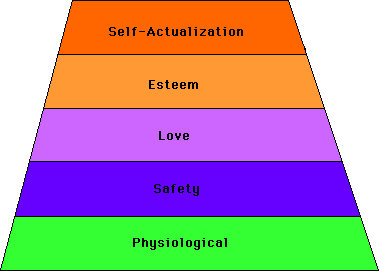Maslow's Hierarchy of Needs
Abraham Maslow is known for establishing the theory of a hierarchy of needs, writing that human beings are motivated by unsatisfied needs, and that certain lower needs need to be satisfied before higher needs can be satisfied. Maslow studied exemplary people such as Albert Einstein, Jane Addams, Eleanor Roosevelt, and Frederick Douglas rather than mentally ill or neurotic people. This was a radical departure from two of the chief schools of pyschology of his day: Freud and B.F. Skinner. Freud saw little difference between the motivations of humans and animals. We are supposedly rational beings; however, we do not act that way. Such pessimism, Maslow believed, was the result of Freud's study of mentally ill people. "The study of crippled, stunted, immature, and unhealthy specimens can yield only a cripple psychology and a cripple philosophy" (Motivation and Personality). Skinner, on the other hand, studied how pigeons and white rats learn. His motivational models were based on simple rewards such as food and water, sex, and avoidance of pain. Say "sit" to your dog and give the dog a treat when it sits, and-after several repetitions--the dog will sit when you command it to do so. Maslow thought that psychologists should instead study the playfulness, affection, etc., of animals. He also believed that Skinner discounted things that make humans different from each other. Instead, Skinner relied on statistical descriptions of people.
Maslow's hierarchy of needs was an alternative to the depressing determinism of Freud and Skinner. He felt that people are basically trustworthy, self-protecting, and self-governing. Humans tend toward growth and love. Although there is a continuous cycle of human wars, murder, deceit, etc., he believed that violence is not what human nature is meant to be like. Violence and other evils occur when human needs are thwarted. In other words, people who are deprived of lower needs such as safety may defend themselves by violent means. He did not believe that humans are violent because they enjoy violence. Or that they lie, cheat, and steal because they enjoy doing it.
According to Maslow, there are general types of needs (physiological, safety, love, and esteem) that must be satisfied before a person can act unselfishly. He called these needs "deficiency needs." As long as we are motivated to satisfy these cravings, we are moving towards growth, toward self-actualization. Satisfying needs is healthy, blocking gratification makes us sick or evil. In other words, we are all "needs junkies" with cravings that must be satisfied and should be satisfied. Else, we become sick.
Needs are prepotent. A prepotent need is one that has the greatest influence over our actions. Everyone has a prepotent need, but that need will vary among individuals. A teenager may have a need to feel that he/she is accepted by a group. A heroin addict will need to satisfy his/her cravings for heroin to function normally in society, and will not worry about acceptance by other people. According to Maslow, when the deficiency needs are met:
At once other (and higher) needs emerge, and these, rather than physiological hungers, dominate the organism. And when these in turn are satisfied, again new (and still higher) needs emerge, and so on. As one desire is satisfied, another pops up to take its place.
Physiological needs are the very basic needs such as air, water, food, sleep, sex, etc. When these are not satisfied we may feel sickness, irritation, pain, discomfort, etc. These feelings motivate us to alleviate them as soon as possible to establish homeostasis. Once they are alleviated, we may think about other things.
Safety needs have to do with establishing stability and consistency in a
chaotic world. These needs are mostly psychological in nature. We need the
security of a home and family. However, if a family is dysfunction, i.e., an
abusive husband, the wife cannot move to the next level because she is
constantly concerned for her safety. Love and belongingness have to wait until
she is no longer cringing in fear. Many in our society cry out for law and
order because they do not feel safe enough to go for a walk in their
neighborhood. Many people, particularly those in the inner cities,
unfortunately, are stuck at this level. In addition, safety needs sometimes
motivate people to be religious. Religions comfort us with the promise of a
safe secure place after we die and leave the insecurity of this world.
Love and belongingness are next on the ladder. Humans have a desire to
belong to groups: clubs, work groups, religious groups, family, gangs, etc. We
need to feel loved (non-sexual) by others, to be accepted by others.
Performers appreciate applause. We need to be needed. Beer commercials, in
addition to playing on sex, also often show how beer makes for camaraderie.
When was the last time you saw a beer commercial with someone drinking beer
alone?
There are two types of esteem needs. First is self-esteem which results
from competence or mastery of a task. Second, there's the attention and
recognition that comes from others. This is similar to the belongingness
level, however, wanting admiration has to do with the need for power. People
who have all of their lower needs satisfied, often drive very expensive cars
because doing so raises their level of esteem. "Hey, look what I can
afford-peon!"
The need for self-actualization is "the desire to become more and more what one is, to become everything that one is capable of becoming." People who have everything can maximize their potential. They can seek knowledge, peace, esthetic experiences, self-fulfillment, oneness with God, etc. It is usually middle-class to upper-class students who take up environmental causes, join the Peace Corps, go off to a monastery, etc.
More Reading
George Norwood, Maslow's Hierarchy of Needs, http://www.connect.net/georgen/maslow.htm, June, 1996.
Abraham Maslow, Motivation and Personality, 2nd ed., Harper & Row, 1970.
© 1997, Robert Gwynne
